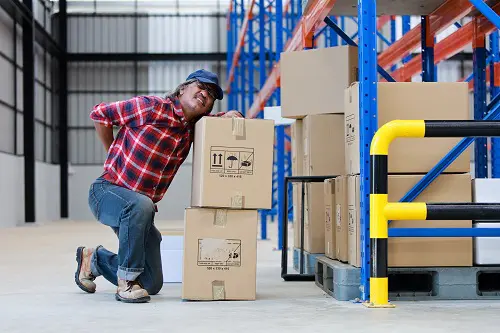
A back injury is the top cause of job related disability. There are more than 1 million back injuries sustained in the workplace annually.
As a whole, back injuries account for 20% of all illnesses and injuries in the workplace. Eighty percent of adults are estimated to experience a back injury in their lifetime. About 4-5% of back conditions will become chronic and disabling.
How to prevent back injuries on the job
There are a number of ways that you can minimize risk to back injuries in the workplace and at home:
Tip 1: Get as close to the load as possible
The further the load is from the centerline of your body, the greater the strain imposed on your back. Squat down to lift the load and pull it between your legs, this gets the load closer to the center of your body, helping prevent the need to bend at the waist. In addition to lifting the load, you are also hoisting the majority of your body weight. In order to avoid picking up heavy objects placed below your knees, try to ensure heavy objects are placed and stored above knee level, but below shoulder level.
Tip 2: If you suspect the load is too heavy to lift comfortably – do not risk it.
Using mechanical aid, break the load down into parts, or get help. The most common cause of back injury is overloading.
Tip 3: Keep your back straight.
Refrain from bending at the waist when reaching to lift an object. Keep the natural arch in your lower back which distributes the load evenly over the surface of your spinal discs, and is less stressful than if the disc is pinched between the vertebrae face. Bending principally from the hips is acceptable if you maintain the arching your back, rather than bending at the waist.
Tip 4: Glue your hand to your thigh.
When carrying a load in one hand, such as a toolbox, place your free hand on the outside of your thigh and mentally glue it into position. This will help you maintain correct back alignment, rather than lifting and tilting to one side when carrying a heavy load. Side bending can be just as stressful to the spine as bending forward.
Tip 5: Tighten your stomach muscles.
This technique helps your spine while twisting. If you lift a load and need to place it off to one side, turn by moving your feet. After repeated lifts you might find yourself getting a bit sloppy, forgetting to move your feet, you can overcome this tendency if the place you set the load down is at least one step away from where it was lifted.
Tip 6: Stay in good physical condition.
A protruding stomach is an extra load being carried away from the centerline of the body, which prevents you from keeping the lifted object close. When you bend at the waist to lift, due to the leverage principle, the load is up to 10 times heavier than its actual weight. A potbelly puts extra stress and weight on the spine
Tip 7: Stretch and loosen up before work.
Research has shown that trunk flexibility and mobility is significantly lower in the morning than later in the day. This will increase the number and severity of back strains at this time. A few minutes of stretching can warm up cold, stiff muscles and tendons that help you avoid an injury. All professional athletes know this, industrial athletes should know this too.
Injure your back at work? Contact us today.
If you or someone you know has suffered a back injury in the workplace, contact the workers’ compensation attorneys at Shannon Law Group. With firsthand, on the job, experience, our injury lawyers know how to fight for you. Contact us at (312) 578-9501 today!
Schedule Your Free Consultation Today



